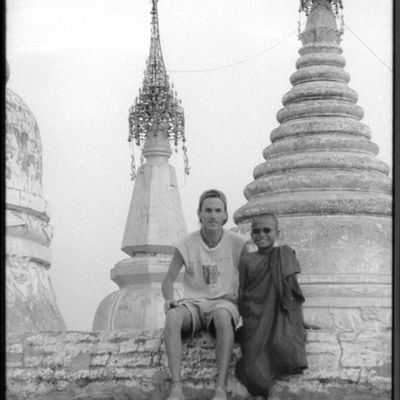
A Musical Odyssey Along the Silk Road
Downtown Los Angeles, Los Angeles
Sat, June 8, 2024, at 6:00 PM,
PDT

- Bring your own drinks
- Alcoholic and non-alcoholic drinks provided
-

- All guests must be 21
-
Wheelchair access
- Wheelchair Accessible
This is a groupmuse
A live concert in a living room, backyard, or another intimate space. They're casual and friendly, hosted by community members.
Hosts

ROUNDCOLLAB will be presenting an exhibition celebrating Queer Asian Pride in conjunction with AAPI Heritage (May) and LGBT Pride (June) months in both San Francisco and Los Angeles. We invite musicians to join us in hosting local community members for the Saturday concerts in conjunction with the exhibition at The Bloc in Los Angeles, sponsored by DTLA Proud's A+R=T community center. The music program should start at 6:00pm and end around 8:30 to 9:00pm which includes 2 sets of 20-25 mins long with intermission.
What's the music?
Program Notes: A Musical Odyssey Along the Silk Road
Embark on a Journey of Discovery
Tonight, we invite you on a remarkable musical journey that traces the ancient Silk Road, the historic network of trade routes that connected the East and West from Central China to Central Asia. This program, meticulously crafted to blend vocal pieces with the enchanting sounds of traditional Chinese instruments, along with instrumental solos and ensemble pieces, promises to transport you across time and space.
Where does this music come from?
Historical Context: The Musical Journey from Central China to Central Asia on the Strings of Erhu and Guzheng
Introduction to the Instruments
The erhu and guzheng are among the most celebrated traditional Chinese instruments, each with a rich history that spans centuries. The erhu, a two-stringed bowed instrument, is known for its poignant and expressive sound, capable of conveying a wide range of emotions. It has a relatively simple construction with a long neck and a small resonating body covered with python skin. Despite its humble appearance, the erhu is a powerhouse of musical expression, often compared to the human voice in its capacity to evoke deep feelings.
The guzheng, a plucked zither with a history dating back over 2,500 years, is known for its beautiful, harp-like sound. It typically has 21 strings and movable bridges, allowing for a wide range of pitches and tonalities. The guzheng’s repertoire includes both traditional folk tunes and more contemporary pieces, showcasing its versatility and enduring appeal.
Musical Traditions of Central China
Central China, with its diverse ethnic groups and rich cultural tapestry, has been a cradle of musical innovation for millennia. The region’s music is characterized by its lyrical melodies, intricate rhythms, and a profound sense of emotion. Instruments like the erhu and guzheng play a pivotal role in this musical landscape, serving as key voices in the expression of Chinese cultural identity.
In traditional Chinese music, the concept of “Yin and Yang” and the philosophy of Confucianism, Taoism, and Buddhism are often reflected in the music’s structure and themes, emphasizing harmony, balance, and a deep connection to nature and the cosmos. The erhu and guzheng, with their emotive and resonant sounds, are perfect vehicles for these expressions, weaving together melodies that reflect the human experience within the natural world.
The Silk Road: A Musical Highway
The Silk Road served as a significant conduit for the exchange of musical traditions between Central China and Central Asia. As traders and travelers moved along these routes, they carried with them not just silk and spices but also musical instruments, ideas, and styles. This exchange led to a rich cross-pollination of musical traditions, influencing the development of music in regions far beyond China’s borders.
Instruments similar to the erhu and guzheng can be found in various forms across Central Asia, evidence of this historical interchange. The music of the Silk Road is a testament to the power of cultural exchange, blending the distinct musical languages of different peoples into something new and vibrant. This fusion is particularly evident in the repertoire for these instruments, which includes pieces that incorporate Central Asian scales, modes, and rhythms, alongside traditional Chinese compositions.
Conclusion: The Enduring Legacy of Erhu and Guzheng Music
The music of the erhu and guzheng, from Central China to Central Asia, represents a journey through time and space, encapsulating the essence of the Silk Road’s legacy. These instruments, with their rich historical backgrounds and unique sounds, continue to captivate audiences around the world, serving as ambassadors of Chinese musical heritage.
As we explore the music performed on the erhu and guzheng, we are reminded of the enduring human desire for connection and expression. The melodies that once echoed along the Silk Road continue to resonate today, a testament to the timeless power of music to transcend boundaries and bring cultures closer together.
Location
Exact address sent to approved attendees via email.
This is a groupmuse
A live concert in a living room, backyard, or another intimate space. They're casual and friendly, hosted by community members.
Hosts


 Continue with Facebook
Continue with Facebook
 Continue with Google
Continue with Google
 Continue with Apple
Continue with Apple
Comments
Comment sections are only for participants.